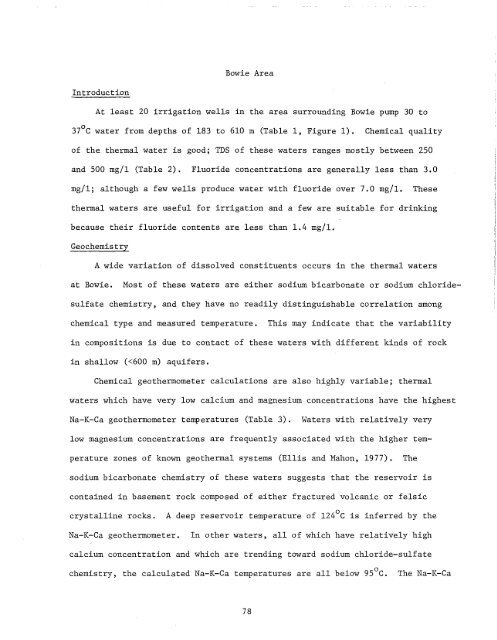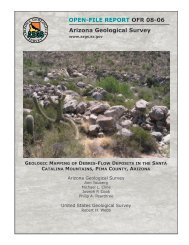geothermal resource potential of the safford-san simon basin, arizona
geothermal resource potential of the safford-san simon basin, arizona
geothermal resource potential of the safford-san simon basin, arizona
Create successful ePaper yourself
Turn your PDF publications into a flip-book with our unique Google optimized e-Paper software.
Bowie Area<br />
Introduction<br />
At least 20 irrigation wells in <strong>the</strong> area surrounding Bowie pump 30 to<br />
37°C water from depths <strong>of</strong> 183 to 610 m (Table 1, Figure 1). Chemical quality<br />
<strong>of</strong> <strong>the</strong> <strong>the</strong>rmal water is good; TDS <strong>of</strong> <strong>the</strong>se waters ranges mostly between 250<br />
and 500 mg/l (Table 2). Fluoride concentrations are generally less than 3.0<br />
mg/l; although a few wells produce water with fluoride over 7.0 mg/l.<br />
These<br />
<strong>the</strong>rmal waters are useful for irrigation and a few are suitable for drinking<br />
because <strong>the</strong>ir fluoride contents are less than 1.4 mg/l.<br />
Geochemistry<br />
A wide variation <strong>of</strong> dissolved constituents occurs in <strong>the</strong> <strong>the</strong>rmal waters<br />
at Bowie.<br />
Most <strong>of</strong> <strong>the</strong>se waters are ei<strong>the</strong>r sodium bicarbonate or sodium chloridesulfate<br />
chemistry, and <strong>the</strong>y have no readily distinguishable correlation among<br />
chemical type and measured temperature.<br />
This may indicate that <strong>the</strong> variability<br />
in compositions is due to contact <strong>of</strong> <strong>the</strong>se waters with different kinds <strong>of</strong> rock<br />
in shallow «600 m)<br />
aquifers.<br />
Chemical geo<strong>the</strong>rmometer calculations are also highly variable; <strong>the</strong>rmal<br />
waters which have very low calcium and magnesium concentrations have <strong>the</strong> highest<br />
Na-K-Ca geo<strong>the</strong>rmometer temperatures (Table 3).<br />
Waters with relatively very<br />
low magnesium concentrations are frequently associated with <strong>the</strong> higher temperature<br />
zones <strong>of</strong> known <strong>geo<strong>the</strong>rmal</strong> systems (Ellis and Mahon, 1977).<br />
The<br />
sodium bicarbonate chemistry <strong>of</strong> <strong>the</strong>se waters suggests that <strong>the</strong> reservoir is<br />
contained in basement rock composed <strong>of</strong> ei<strong>the</strong>r fractured volcanic or felsic<br />
crystalline rocks.<br />
A deep reservoir temperature <strong>of</strong> l24°C is inferred by <strong>the</strong><br />
Na-K-Ca geo<strong>the</strong>rmometer.<br />
In o<strong>the</strong>r waters, all <strong>of</strong> which have relatively high<br />
calcium concentration and which are trending toward sodium chloride-sulfate<br />
o<br />
chemistry, <strong>the</strong> calculated Na-K-Ca temperatures are all below 95 C.<br />
The Na-K-Ca<br />
78

















